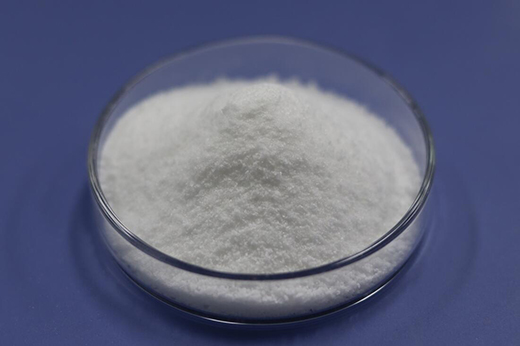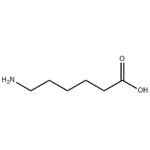The preparation of 6-aminocaproic
Introduction
6-Aminocaproic acid is an organic substance with the molecular formula of C6H13O2N, NH2(CH2)5COOH and a white crystalline powder. It is an antifibrinolytic agent and can inhibit plasminogen activator[1].

Picture 1 6-Aminocaproic acid powders
The preparation of 6-aminocaproic
It is obtained by hydrolysis of caprolactam. Add caprolactam, concentrated hydrochloric acid and 3 times the amount of distilled water into the reaction tank, stir, heat up and reflux for 1.5h, and control the temperature to 103-106°C. After the reaction, the conversion rate should be more than 95%. Add distilled water to dilute to 10% concentration to obtain 10% 6-aminocaproic acid hydrolyzate. The hydrolyzed solution was uniformly flowed into the ion exchange column [packed with 001×7 (732#) strongly acidic styrene-based cation exchange resin] at a flow rate of 5-10L per hour for adsorption. Close the outlet after the flow is finished and soak overnight. Wash the ion exchange column with distilled water to remove the hydrochloric acid (check the effluent to be free of chloride ions). Then, 3.5% ammonium hydroxide was uniformly flowed in at a flow rate of 5-10 L per hour. After the flow is finished, close the flow outlet and soak overnight. After the ammonium hydroxide was continued on the next day, it was eluted with distilled water, and the eluate containing 6-aminocaproic acid was collected. Add activated carbon to decolorize, filter, and concentrate the filtrate under reduced pressure at 47-70°C to near dryness. Add ethanol while hot, and stir to precipitate crystals. After cooling, filter the crude product. The crude product was dissolved in distilled water, decolorized by adding activated carbon at 60 °C for 1 h. Filter while hot. The filtrate was concentrated under reduced pressure to near dryness. Add ethanol to separate out crystals, cool, shake off and filter, wash the crystals with ethanol, and dry to obtain 6-aminocaproic acid. The overall yield to caprolactam is 75-80%[2].
The action and use of 6-aminocaproic
6-Aminohexanoic acid was used as a biochemical reagent. 6-Aminocaproic acid is used in organic synthesis. As an anti-fibrinolytic agent. Used as a hemostatic agent. 6-aminocaproic acid has a significant effect on some severe bleeding caused by increased fibrinolytic activity. It is suitable for oozing or local bleeding during various surgical operations. 6-aminocaproic acid is also used for hemoptysis, gastrointestinal bleeding and bleeding disorders in obstetrics and gynecology. 6-Aminocaproic acid works by inhibiting the fibrinolytic system. Mainly used for hemorrhage caused by elevated plasmin activity, such as obstetrics and gynecology hemorrhage, hemorrhage after prostate, liver, pancreas, lung and other visceral operations. Early intraoperative medication or preoperative medication can reduce intraoperative oozing and reduce blood transfusion volume.
6-Aminocaproic acid is an anti-fibrinolytic drug with a similar chemical structure to lysine. It can qualitatively inhibit the binding of plasminogen to fibrin and prevent its activation, thereby inhibiting fibrinolysis and achieving hemostasis. Aminocaproic acid is a monoaminocarboxylic acid, which can inhibit the conversion of plasminogen into plasmin and its binding to fibrin. For severe bleeding caused by hyperfibrinolysis caused by increased activation of plasminogen, Can have therapeutic effect.
The instructions of 6-aminocaproic
Intravenous infusion of 6-aminocaproic acid, the initial dose is 4 ~ 6g, diluted with 5% ~ 10% glucose or 100ml of normal saline, the maintenance dose is 1g per hour, and the maintenance time depends on the condition. Oral, 2g each time for adults, 3 to 4 times a day, 0.1g/kg for children.
Side effects and precautions
6-aminocaproic acid can form thrombus in overdose, and it is contraindicated in patients with thrombotic tendency or history of thrombotic vascular disease. Use with caution in patients with renal insufficiency.
Reference
1 Li Pai, Wu Jiami, Chu Zhaohu, Liu Chunmei. Clinical study of 6-aminocaproic acid combined with nimodipine in the treatment of subarachnoid hemorrhage. 2003
2 Liu Xufeng, Guan Wenchao, Cheng Zhenxian. Synthesis and solubility of C60 adducts of 6-aminocaproic acid and 2-aminoethanesulfonic acid. 2005
);You may like
See also
Lastest Price from 6-Aminocaproic acid manufacturers

US $0.00/KG2024-04-28
- CAS:
- 60-32-2
- Min. Order:
- 25KG
- Purity:
- 99
- Supply Ability:
- 2mt

US $0.00-0.00/kg2024-04-28
- CAS:
- 60-32-2
- Min. Order:
- 1kg
- Purity:
- 99%
- Supply Ability:
- 1T+


